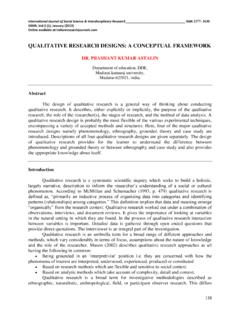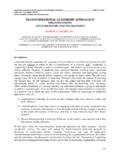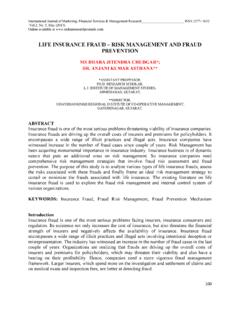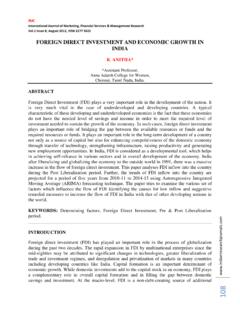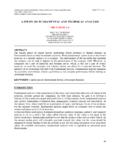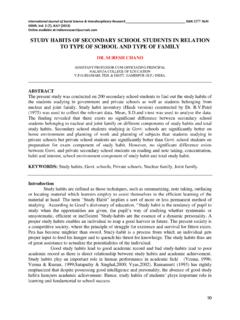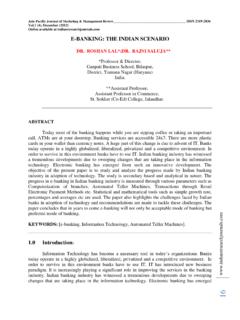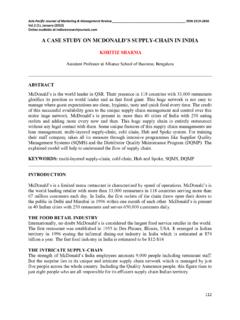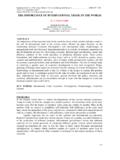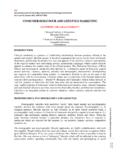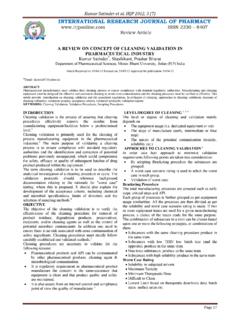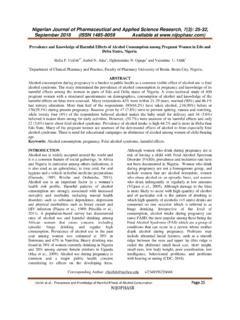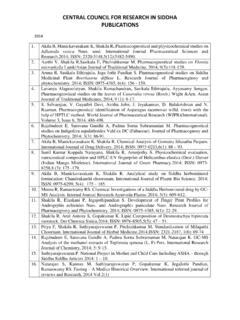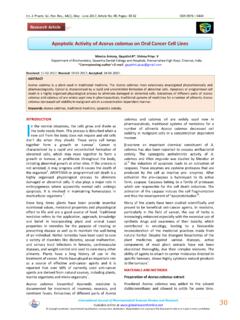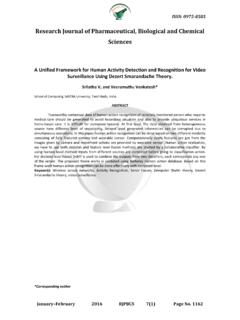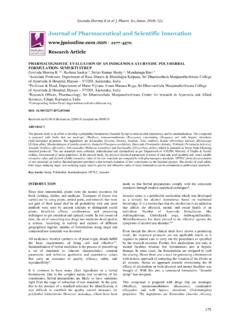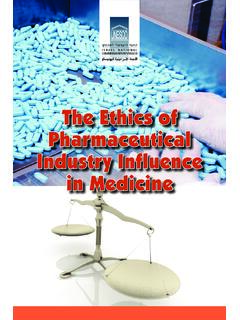Transcription of SWOT ANALYSIS OF INDIAN PHARMACEUTICAL INDUSTRY
1 International journal of Marketing, Financial Services & Management Research_____ ISSN 2277- 3622 , No. 5, May (2013) Online available at 26 swot ANALYSIS OF INDIAN PHARMACEUTICAL INDUSTRY KAPIL KUMAR*; DR. M. K. KULSHRESHTHA** * research SCHOLAR, BHAGWANT UNIVERSITY, AJMER ** DIRECTOR, S. D. COLLEGE OF MANAGEMENT, PANIPAT _____ ABSTRACT The global PHARMACEUTICAL market is undergoing rapid transformation. There has been a dramatic shift towards emerging markets as western markets slow down. Global Pharma multinational corporations are looking at new growth drivers such as the INDIAN domestic market to capitalise on the growing opportunity. The huge potential of the INDIAN PHARMACEUTICAL INDUSTRY is impossible for global Pharma companies to ignore, given that India will be one of the top 10 sales markets in the world by 2020.
2 Some of the largest Pharma companies in the world have been in the INDIAN market since the 1970s, and 5 out of the top 10 domestic Pharma companies are already foreign owned, with a consolidated share of 22 23%. India s domestic PHARMACEUTICAL market has recorded a CAGR of over the past five years.(5) With considerable expertise in manufacturing of generics and vaccines, INDIAN companies have now also started significant research and development (R&D). The INDIAN economy is growing strongly and healthcare is expanding to meet the needs of a growing population with a changing disease profile. Increase in insurance coverage, aggressive market creation, growth in the income of the INDIAN population and steady government investment into medical infrastructure has further propelled the growth of the INDUSTRY , such that it is on the threshold of becoming a competitor of global Pharma companies in some key areas, and a potential partner in others.
3 KEYWORDS: FDI in Pharma, generic drugs, export and import in pharma, swot ANALYSIS , pharma INDUSTRY concentration. _____ INTRODUCTION The INDIAN PHARMACEUTICAL INDUSTRY ranks among the top five countries by volume (production) and accounts for about 10% of global production. The INDUSTRY s turnover has grown from a mere US$ bn in 1980 to about US$ bn in 2009-10. Low cost of skilled manpower and innovation are some of the main factors supporting this growth. According to the Department of Pharmaceuticals, the INDIAN PHARMACEUTICAL INDUSTRY employs about 340,000 people and an estimated 400,000 doctors and 300,000 chemists. The INDIAN PHARMACEUTICAL INDUSTRY is fragmented with more than 10,000 manufacturers in the organised and unorganised International journal of Marketing, Financial Services & Management Research_____ ISSN 2277- 3622 , No.
4 5, May (2013) Online available at 27 segments. The products manufactured by the INDIAN PHARMACEUTICAL INDUSTRY can be broadly classified into bulk drugs (active PHARMACEUTICAL ingredients - API) and formulations. Of the total number of PHARMACEUTICAL manufacturers, about 77% produce formulations, while the remaining 23% manufacture bulk drugs. Bulk drug is an active constituent with medicinal properties, which acts as basic raw material for formulations. Formulations are specific dosage forms of a bulk drug or a combination of bulk drugs. Drugs are sold as syrups, injections, tablets and capsules. Based on the PHARMACEUTICAL customer base, the INDIAN API manufacturing segment can be divided into two sectors innovative or branded and generic or unbranded.
5 In 2009, the global generic drug market was estimated to be US$ 84 bn, of which the US accounted for 42%. India s generic drug INDUSTRY is estimated to be US$ 19 bn and it ranks third globally, contributing about 10% to global PHARMACEUTICAL production. PHARMACEUTICAL manufacturing units are largely concentrated in Maharashtra and Gujarat. These states account for about 45% of the total number of PHARMACEUTICAL manufacturing units in India. I. Investment In The INDIAN PHARMACEUTICAL INDUSTRY 100% foreign direct investment (FDI) is allowed under automatic route in the drugs and pharmaceuticals sector, including those involving use of recombinant technology. Also, FDI up to 100% is permitted for brownfield investments ( investments in existing companies), in the pharmaceuticals sector, under the Government approval route.
6 The drugs and pharmaceuticals INDUSTRY attracted foreign direct investment to the tune of US$ bn for the period between April 2000 and January 2012. International journal of Marketing, Financial Services & Management Research_____ ISSN 2277- 3622 , No. 5, May (2013) Online available at 28 The INDIAN PHARMACEUTICAL INDUSTRY enjoys certain advantages, which attracts FDI in the country: 1) low cost of innovation and capital expenditure (to operate good manufacturing practices-compliant facilities) which provides leverage in pricing of drugs 2) transparency in the regulatory framework 3) proven track record in bulk drug and formulation patents 4) strong domestic support in production, from raw material requirements to finished goods and 5) India emerging as a hub for contract research , bio-technology, clinical research and clinical data management.
7 II. Factors Influencing Growth Of The INDUSTRY The INDIAN PHARMACEUTICAL INDUSTRY ranks 14th in the world by value of PHARMACEUTICAL products. With a well-established domestic manufacturing base and low-cost skilled manpower, India is emerging as a global hub for pharma products and the INDUSTRY continues to be on a growth trajectory. Moreover, India is significantly ahead in providing chemistry services such as analogue preparation, analytical chemistry and structural drug design, which will provide it ample scope in contract research and other emerging segments in the PHARMACEUTICAL INDUSTRY . Some of the major factors that would drive growth in the INDUSTRY are as follows: 1.
8 The Growing INDIAN Economy: The INDIAN economy is growing fast, and is valued at US$ trillion in 2010. GDP growth, calculated on a Purchasing Power Parity basis has reached in the year 2010, and the International Monetary Fund (IMF) expects it to remain consistently above 8% till 2015. Furthermore, India s share in the world GDP has been steadily increasing, and is expected to reach in 2015, up from in 2005. International journal of Marketing, Financial Services & Management Research_____ ISSN 2277- 3622 , No. 5, May (2013) Online available at 29 2. Increase in domestic demand: More than half of India s population does not have access to advanced medical services, as they usually depend on traditional medicine practices.
9 However, with increase in awareness levels, rising per capita income, change in lifestyle due to urbanisation and increase in literacy levels, demand for advanced medical treatment is expected to rise. Moreover, growth in the middle class population would further influence demand for PHARMACEUTICAL products. 3. Rise in outsourcing activities: Increase in the outsourcing business to India would also drive growth of the INDIAN PHARMACEUTICAL INDUSTRY . Some of the factors that are likely to influence clinical data management and bio-statistics markets in India in the near future include: 1) cost efficient research vis- -vis other countries 2) highly-skilled labour base 3) cheaper cost of skilled labour 4) presence in end-to-end solutions across the drug-development spectrum and 5) robust growth in the IT INDUSTRY .
10 4. Growth in healthcare financing products: Development in the INDIAN financial INDUSTRY has eased healthcare financing with introduction of products such as health insurance policy, life insurance policy and cashless claims. This has resulted in increase in healthcare spending, which in turn, has benefitted the PHARMACEUTICAL INDUSTRY . 5. Demand in the generics market: During 2008-2015, prescription drugs worth about US$ 300 bn are expected to go off patent, mostly from the US. Prior experience of INDIAN PHARMACEUTICAL companies in generic drugs would provide an edge to them. 6. Demand from emerging segments: Some of the emerging segments such as contract research and development, bio-pharma, clinical trials, bio-generics, medical tourism and pharma packaging are also expected to drive growth of the INDIAN PHARMACEUTICAL INDUSTRY .
